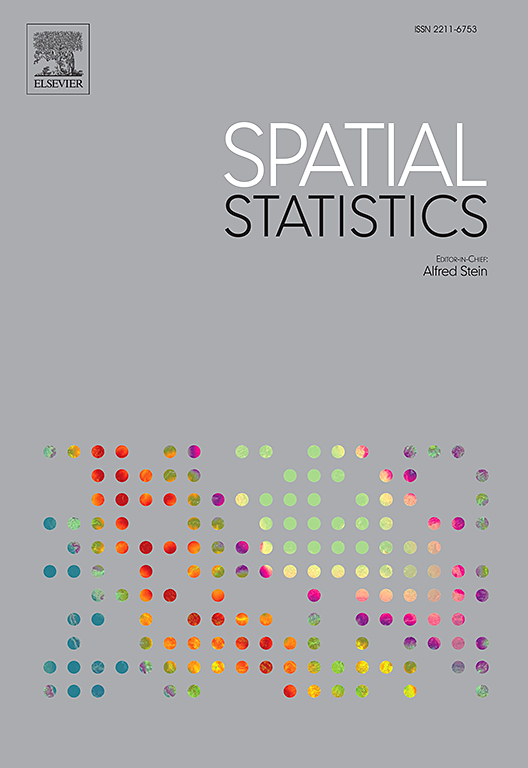结合渔业依赖和渔业独立来源的零膨胀数据联合模型
IF 2.5
2区 数学
Q3 GEOSCIENCES, MULTIDISCIPLINARY
引用次数: 0
摘要
准确识别物种分布的空间模式对于科学洞察力和社会效益至关重要,有助于我们理解物种波动。生态数据集的数量和质量的不断提高对统计提出了更高的挑战,使空间物种动态的理解复杂化。为了解决整合多个数据源以增强海洋生态学中鱼类空间分布认识的复杂任务,本研究引入了一个开创性的五层联合模型。该模型巧妙地整合了渔业独立和渔业依赖的数据,适应零膨胀数据和不同的采样过程。综合仿真研究评估了模型在各种优先采样场景和样本量下的性能,阐明了其优势和挑战。我们的发现突出了模型在估计优先参数方面的稳健性,强调了存在-缺失和生物量观测之间的区别。对空间协方差估计和预测性能的评价强调了模型的可靠性。增加样本量减少了参数估计的可变性,与增加的信息增强确定性的原则保持一致。评估每个数据源的贡献揭示了成功的整合,提供了生物量模式的全面表示。在现实环境中的经验应用进一步巩固了模型在捕捉物种空间分布方面的有效性。这项研究推进了整合不同采样性质的不同数据集的方法,进一步有助于对海洋物种的空间动态有更深入的了解。本文章由计算机程序翻译,如有差异,请以英文原文为准。
Joint model for zero-inflated data combining fishery-dependent and fishery-independent sources
Accurately identifying spatial patterns of species distribution is crucial for scientific insight and societal benefit, aiding our understanding of species fluctuations. The increasing quantity and quality of ecological datasets present heightened statistical challenges, complicating spatial species dynamics comprehension. Addressing the complex task of integrating multiple data sources to enhance spatial fish distribution understanding in marine ecology, this study introduces a pioneering five-layer Joint model. The model adeptly integrates fishery-independent and fishery-dependent data, accommodating zero-inflated data and distinct sampling processes. A comprehensive simulation study evaluates the model performance across various preferential sampling scenarios and sample sizes, elucidating its advantages and challenges. Our findings highlight the model’s robustness in estimating preferential parameters, emphasizing differentiation between presence–absence and biomass observations. Evaluation of estimation of spatial covariance and prediction performance underscores the model’s reliability. Augmenting sample sizes reduces parameter estimation variability, aligning with the principle that increased information enhances certainty. Assessing the contribution of each data source reveals successful integration, providing a comprehensive representation of biomass patterns. Empirical application within a real-world context further solidifies the model’s efficacy in capturing species’ spatial distribution. This research advances methodologies for integrating diverse datasets with different sampling natures further contributing to a more informed understanding of spatial dynamics of marine species.
求助全文
通过发布文献求助,成功后即可免费获取论文全文。
去求助
来源期刊

Spatial Statistics
GEOSCIENCES, MULTIDISCIPLINARY-MATHEMATICS, INTERDISCIPLINARY APPLICATIONS
CiteScore
4.00
自引率
21.70%
发文量
89
审稿时长
55 days
期刊介绍:
Spatial Statistics publishes articles on the theory and application of spatial and spatio-temporal statistics. It favours manuscripts that present theory generated by new applications, or in which new theory is applied to an important practical case. A purely theoretical study will only rarely be accepted. Pure case studies without methodological development are not acceptable for publication.
Spatial statistics concerns the quantitative analysis of spatial and spatio-temporal data, including their statistical dependencies, accuracy and uncertainties. Methodology for spatial statistics is typically found in probability theory, stochastic modelling and mathematical statistics as well as in information science. Spatial statistics is used in mapping, assessing spatial data quality, sampling design optimisation, modelling of dependence structures, and drawing of valid inference from a limited set of spatio-temporal data.
 求助内容:
求助内容: 应助结果提醒方式:
应助结果提醒方式:


